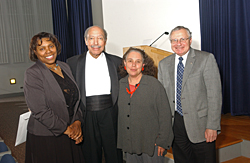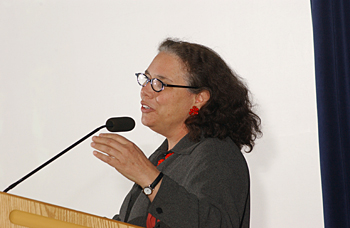An award-winning, internationally known artist, Saar, through words and images, took her audience of approximately 100 UD students, faculty and staff on an eye-popping journey that touched on lost identities, madness, strained relations between blacks and whites, conflicted issues of self-image, and outward masks versus inward emotions.
“When I speak at universities, I like to include really early work,” Saar said, beginning her lecture with a slide of a crudely carved 13-inch-tall African-American puppet/effigy made from a 4-by-4 plank of found wood.
“I have always been drawn to sculptural forms, and this piece marks the beginning of that path,” Saar said. She went on to explain how working in three dimensions better enabled her to show inner and outer worlds, and pointed out that the puppet, which had a trap door in its chest, represented this duality. “This puppet holds resentment,” Saar said. “I have always been very much interested in representing the inner spirit, and several of my early sculptures have doors that can be opened and closed to show an interior and exterior world.”
Moving through slides that included more figures and busts carved mostly from wood, Saar explained how the different images addressed issues of homelessness, living with being HIV-positive and simmering emotions of hatred and distrust.
After showing many of her earlier works, Saar brought the audience up to date with several contemporary pieces, many of which dealt with hair as symbol for entrapment, madness and African Americans' pursuit--or rejection--of aesthetic standards considered the epitome of Caucasian beauty.
“I became obsessed with hair and with things embedded in the hair,” Saar said, showing a slide titled “Blonde Dream,” that depicted a sculpted head of an African-American woman with heavily processed hair.
“I got fascinated with my own hair trapping things and of using hair as a symbol of history and of dreams and aspirations, and also of madness,” Saar said.
“I did a series of pieces that were about the body, and about the spirit, too,” Saar continued, moving on to works that she said were contemporary takes on classic sculptures and themes, such as the “foxy” slaves sculpted by Michelangelo and the lovely odalisques painted by the Dutch masters and post-Impressionists.

“I wanted to depict invisible populations--men who worked in yards and women who abandoned their own families to work as domestic servants,” Saar said.
Recently commissioned to do a sculpture of Harriet Tubman for the corner of 122nd Street and Frederick Douglass Place in New York City, Saar brought her slideshow and lecture to a close with an image of the maquette for the sculpture, which will be, upon completion, a 13-foot-tall-by-8-foot-wide permanent installation.
A native of Los Angeles, Saar earned her bachelor's degree in art history from Scripps College in 1978 and her master's degree in fine art from Otis/Parsons School of Design in 1981. She is a scholar on self-taught African-American artists and on the art and religions of several African, Latin-American and Caribbean cultures.
The lecture, which marked the fifth year of the annual event, was attended by UD art benefactor Paul R. Jones.
Article by Becca Hutchinson
Photos by Duane Perry



